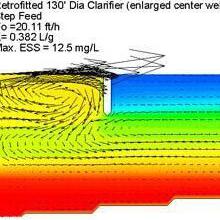CFD Modeling Can Lead the Way to Cost-Effective Improvements

In water and wastewater treatment processes often one or more chemicals are introduced and mixed into a flowing stream. The chemicals can be a polymer to enhance flocculation, a disinfectant to meet CT requirements, or caustic to adjust the pH range. The moving stream can be a full pipe flowing or an open channel. For drinking water, chlorine may be added to the treated water at pump discharge header leading to the distribution system. Mixing of the injected chemical with the flow stream should not be taken for granted. Insufficient mixing can lead to overuse of chemicals, poor distribution before flow splitting, higher energy use, misleading residual measurements and feedback operations, etc. Facilities need to get this right and in many cases rule of thumb assumptions do not provide optimal solutions.
The choice of injection/mixing devices between single or multi-port diffusers, static mixers, and mechanical mixers are not often obvious. Diffusers provide more instantaneous mixing but require pumped dilution water therefore have a higher operational cost. Static mixers can be less expensive but take up a larger space. Performance of static mixers may deviate when flow varies over a wide range. Mechanical mixers are more commonly used in tanks. Other factors such as system layout and client preference can dictate the selection. Quantifying the degree of mixing presents even more challenges. A common sense measure is to achieve the required mixing before a designated downstream location, for example, the first user in a drinking water distribution system, or an ocean outfall of treated effluent from a wastewater treatment plant.
Computational Fluid Dynamics (CFD) modeling is a cost-effective tool to evaluate and optimize different chemical injection and mixing design alternatives. CFD can quantitatively determine if the designs have achieved the required mixing and keep it from being over-designed (lower capital cost) and improve operations efficiencies (lower O&M). In this paper, we will present several recent CFD applications for multiport diffusers, static mixers and mechanical mixers, and how CFD helped save the capital and operational costs. Compared to other conventional metrics for measuring mixing intensity such as baffling factor or velocity gradients, CFD is intuitive, quantitative and provides detailed flow and chemical distributions. CFD has replaced the more expensive physical modeling and is continuing to gain acceptance by owners, operators and federal and state regulatory agencies that provide permit approvals.







